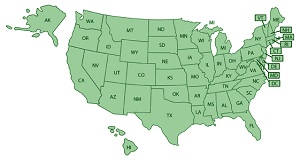Do you live in a green state?
 In this time of oil spills and global warming, polar cap melting and Prius-buying, the hottest word out there today is that environmentally friendly color: green.
In this time of oil spills and global warming, polar cap melting and Prius-buying, the hottest word out there today is that environmentally friendly color: green.
“Being green” refers to reducing damage to the environment and trying to help protect nature’s assets. When it comes to states though, being green takes a lot.
It means having low per-capita emissions, good recycling programs, significant energy usage coming from renewable sources, and clean energy incentives or tax credits for doing things like composting or installing solar panels.
While it’s debated which state is the greenest out of all of those in the union, the same few states pop up at the top of pretty much everyone’s list. This includes Washington, Vermont, and Oregon, each for different reasons.
Washington was credited with having a high number of LEED certified buildings, or buildings that meet a certain code for their emissions and energy conservation. Others are praised for having large renewable energy plants, like the Searsburg Wind Power Facility in Vermont, that powers more than 1,000 homes a year. Not only that, but it’s green business encouragement policies have brought many environmentally friendly companies to the state.
Forbes listed Vermont, Oregon, Washington, Hawaii, Maryland, Connecticut, New Jersey, Rhode Island, New York, and Arizona as the top ten greenest in the states, in that order. While some may seem like a shock, it’s important to remember how many people live there (New Jersey) or how few (Rhode Island); it’s all based on per-capita statistics.
The lowest ranked states included Alabama, Indiana, and West Virginia as the least green states. Now, this doesn’t mean they’re pouring toxic waste into their streams or lighting up rubber tires; it just means that the systems and encouragement to be environmentally friendly are lacking.
While the colors describing states used to be red and blue, a different color is running the show now: Mother Nature green.



